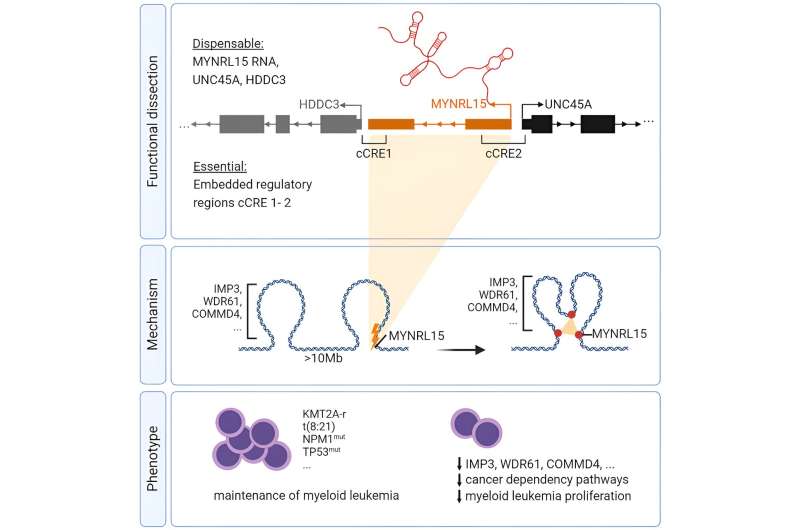This article has been reviewed according to Science X's editorial process and policies. Editors have highlighted the following attributes while ensuring the content's credibility:
fact-checked
peer-reviewed publication
trusted source
proofread
Scientists discover new Achilles heel of leukemia cells

Leukemia is the most common type of cancer in children. Treatment involves intensive chemotherapy, which has severe side effects due to its non-specific mode of action.
A team from the Department of Pediatrics and the Institute for Experimental Pediatric Hematology and Oncology at Goethe University Frankfurt has now discovered a site in the DNA of cancer cells that is essential for leukemia cells to survive. Cancer cells in which the gene encoded at this site was modified experimentally died off. The gene locus thus constitutes a promising target for an alternative therapy in the future.
The term 'leukemia' encompasses various forms of blood cancer, including acute myeloid leukemia (AML). In AML, blood cells in the early stages—the stem cells and the precursor cells that develop out of them—degenerate. AML is the second most common leukemia in children, accounting for around 4% of all malignant diseases in childhood and adolescence.
Despite intensive chemotherapy, only around half of those affected survive without relapsing. About one-third of children are dependent on stem cell donation. Since non-specific chemotherapies have severe side effects, there is an urgent need to find new and specific therapy approaches.
A team led by Jan-Henning Klusmann from the Department of Pediatrics and Dirk Heckl from the Institute for Experimental Pediatric Hematology and Oncology at Goethe University Frankfurt has now discovered an unusual vulnerability in AML cells.
For their study, which has been published in iScience, they looked at a specific group of nucleic acids in leukemia cells: noncoding RNAs. Just like regular messenger RNAs (mRNAs), these are produced through gene transcription.
However, unlike mRNAs, noncoding RNAs are not translated into proteins but instead often assume regulatory functions, for example in cell growth and cell division. A typical characteristic of cancer cells is a massive disruption of regulatory processes. This makes noncoding RNAs an interesting starting point in the fight against cancer.
Against this background, the researchers led by Klusmann and Heckl wanted to know more about the role of noncoding RNAs in AML cells. For this purpose, they compiled a kind of inventory of these molecules in cancer cells taken from sick children and compared the resulting pattern with that of healthy blood stem cells.
AML cells differentially expressed almost 500 noncoding RNAs in comparison to healthy cells—an indication that they could perform an important function in cancer cells. To validate this, the researchers turned off every single one of these RNA molecules by preventing the coding gene in the genome from being read. The most distinct effect they found was for the gene MYNRL15: Cancer cells in which this gene was turned off lost their ability to replicate indefinitely and died off.
Surprisingly, however, it was not the absence of noncoding RNAs that was responsible for this effect, as Klusmann comments, "The regulatory function we observed is due to the MYNRL15 gene itself." The team was able to show that destroying the gene altered the spatial organization of the chromatin, i.e. the three-dimensional structure of the genome.
"This led to the deactivation of genes that AML cells need for survival," says Klusmann. This offers a new and unforeseen possibility for fighting leukemia.
What is significant against this background is the fact that the inhibitory effect triggered by the modified MYNRL15 gene could be observed in different AML cell lines. These cells originated both from children as well as adults and included various subtypes of the disease—among them one common in people with Down syndrome.
"The fact that all the leukemias we studied were dependent on this gene locus tells us it must be important," concludes Klusmann. The researchers now hope that the cancer cells' dependence on MYNRL15 can be used to develop a specific gene therapy.
"In our study, we systematically examined noncoding RNAs and their genes in AML cells for the first time, and in the process, we identified a gene locus that constitutes a promising target for developing a therapy in the future," says Klusmann.
More information: Michelle Ng et al, Myeloid leukemia vulnerabilities embedded in long noncoding RNA locus MYNRL15, iScience (2023). DOI: 10.1016/j.isci.2023.107844


















